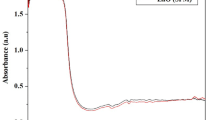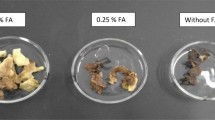Abstract
Allyl isothiocyanate (AITC), a naturally occurring antimicrobial compound, is an effective inhibitor of various pathogens, but its use in the food industry is limited by its volatility and pungency. The objective of this study was to overcome the volatility of AITC using dried Laminaria japonica and mesoporous silica MCM-41 as its carrier. AITC-loaded L. japonica (raw and deoiled) powder and silica MCM-41 was achieved via vapor adsorption. The study of AITC adsorption and desorption was determined by monitoring sample weight changing with time. AITC presence in L. japonica and MCM-41 samples was confirmed by FTIR spectroscopy. Antimicrobial tests were made against 4 microorganisms: Bacillus cereus, Staphylococcus aureus, Escherichia coli, and Salmonella Typhimurium. Controlled release and antimicrobial activity from MCM-41 was always superior to those from raw and deoiled L. japonica.
Similar content being viewed by others
References
Lin C-M, Preston III JF, Wei C-I. Antibacterial mechanism of allyl isothiocynate. J. Food Protect. 63: 724–734 (2000)
Holley RA, Patel D. Improvement in self-life and safety of perishable foods by plant essential oils and smoke antimicrobials. J. Food Microbiol. 22: 273–292 (2005)
Tuari BK, Valdramidis VP, O’Donnell CP, Muthukumarappan K, Bourke P, Cullen PJ. Application of natural antimicrobials for food preservation. J. Agr. Food Chem. 57: 5987–6000 (2009)
Jang M, Hang E, Kim G-H. Evaluation of antibacterial activity of 3-butenyl, 4-pentenyl, 2-phenylethyl, and benzyl isothiocyanate in Brassica vegetables. J. Food Sci. 75: C412–C416 (2010)
Appendini P, Hotchkiss JP. Review of antimicrobial food packaging. J. Innov. Food Sci. Emerg. 3: 113–126 (2002)
Delaquis PJ, Mazza G. Antimicrobial properties of isothiocyanates in food preservation. J. Food Technol. 49: 73–84 (1995)
Avato P, Tursi F, Vitali C, Miccolis V, Candido V. Allylsulfide constituents of garlic volatile oil as antimicrobial agents. Phytomedicine 7: 239–243 (2000)
Nedorostova L, Kloucek P, Kokoska L, Stolcova M, Pulkrabek J. Antimicrobial properties of selected essential oils in vapour phase against foodborne bacteria. J. Food Control 20: 157–160 (2009)
Pechāček R, Velīšek J, Hrabcovā H. Decomposition products of allyl isothiocyanate in aqueous solutions. J. Agr. Food Chem. 45: 4584–4588 (1997)
Hasegawa N, Matsumoto Y, Hoshino A, Iwashita K. Comparison of effect of Wasabia japonica and allyl isothiocyanate on the growth of four strains of Vibrio parahaemolyticus in lean and fatty tuna meat suspensions. Int. J. Food Microbiol. 49: 27–34 (1999)
Park CM, Taormina PJ, Beuchat LR. Efficacy of allyl isothiocyanate in killing enterohemorrhagic Escherichia coli O157:H on alfalfa seeds. Int. J. Food Microbiol. 56: 13–20 (2000)
Lin C-M, Kim J, Du W-X, Wei C-I. Bactericidal activity of isothiocyanate against pathogens on fresh produce. J. Food Protect. 63: 25–30 (2000)
Isshiki K, Tokuoka K, Mari R, Chiba S. Prelimenary examination of allyl isothiocyanate vapor for food preservation. J. Biosci. Biotech. Bioch. 56: 1476–1477 (1992)
Nadarajah D, Han JH, Holley RA. Inactivation of Escherichia coli O157:H7 in packaged ground beef by allyl isothiocyanate. J. Food Microbiol. 99: 269–279 (2005)
Park S-Y, Barton M, Pendelton P. Controlled release of allyl isothiocyanate for bacteria growth management. J. Food Control 23: 478–484 (2012)
Delaquis PJ, Sholberg PL. Antimicrobial activities of gaseous allyl isothiocyanate. J. Food Protect. 60: 943–947 (1997)
Kim YS, Ahn ES, Shin DH. Extension of shelf life by treatment with allyl isothiocyanate in combination with acetic acid on cooked rice. J. Food Sci. 67: 274–279 (2002)
Kim W-T, Chung H, Shin I-S, Yam KL, Chung D. Characterization of calcium alginate and chitosan-treated calcium alginate gel beads entrapping allyl isothiocyanate. Carbohyd. Polym. 71: 566–573 (2008)
Li X, Jin Z, Wang J. Complexation of allyl isothiocyanate by α- and β-cyclodextrin and its controlled release characteristics. J. Food Chem. 103: 461–466 (2007)
Paes JP, Faroni LRA, Martins MA, Dhingra OD, Silva TA. Diffusion and sorption of allyl isothiocynate in the process of fumigation of maize. Agriambi 15: 296–301 (2011)
Altenor S, Ncibi MC, Emmanuel E, Gaspard S. Textural characteristics, physiochemical properties, and adsorption efficiencies of Caribbean alga Turbinaria turbinate and its derived carbonaceous materials for water treatment application. J. Biochem. Eng. 67: 35–44 (2012)
Silva EA, Cossich ES, Tavares CRG, Filho LC, Guirardello R. Modeling of copper (II) biosorption by marine alga Sargassum sp. in fixed-bed coloumn. J. Process Biochem. 38: 791–799 (2002)
Andersson J, Rosenholm J, Lindén M. Mesoporous silica: An alternative diffusion controlled drug delivery system. pp. 5–16. In: Multifunctional Biomaterials and Devices. 9th ed. Ashammakhi N (ed). Finlandia Hall, Helsinki, Finland (2008)
Lin YS, Tsai CP, Huang HY, Kuo CT, Hung Y, Huang DM. Wellordered mesoporous silica nanoparticles as cell markers. J. Chem. Mater. 17: 4570–4573 (2005)
Rankin SE, Tan B, Lehmler HJ, Hindman KP, Knutson BL. Welloredered mesoporous silica prepared by cationic fluorinated surfactant templating. Micropor. Mesopor. Mat. 73: 197–202 (2004)
Qu F, Zhu G, Huang S, Li S, Sun J, Zhang D, Qiu S. Controlled release of captopril by regulating the pore size and morphology of ordered mesoporous silica. Micropor. Mesopor. Mat. 92: 1–9 (2006)
Pērez LD, Lōpez JF, Orozco VH, Kyu T, Lōpez BL. Effect of the chemical characteristics of mesoporous silica MCM-41 on morphological, thermal, and rheological properties of composites based on polystyrene. J. Appl. Polym. Sci. 3: 2229–2237 (2009)
Wang S. Ordered mesoporous materials for drug delivery. Micropor. Mesopor. Mat. 117: 1–9 (2009)
Lowy FD. Staphylococcus aureus infection. New Engl. J. Med. 339: 520–532 (1998)
Enright MC. The evolution of resistant pathogen-the case of MRSA. Curr. Opin. Pharmacol. 3: 474–479 (2003)
Lowy FD. Antimicrobial resistance: The example of Staphylococcus aureus. J. Clin. Invest. 111: 1265–1273 (2003)
Author information
Authors and Affiliations
Corresponding author
Rights and permissions
About this article
Cite this article
Siahaan, E.A., Meillisa, A., Woo, HC. et al. Controlled release of allyl isothiocyanate from brown algae Laminaria japonica and mesoporous silica MCM-41 for inhibiting food-borne bacteria. Food Sci Biotechnol 22 (Suppl 1), 19–24 (2013). https://doi.org/10.1007/s10068-013-0043-7
Received:
Revised:
Accepted:
Published:
Issue Date:
DOI: https://doi.org/10.1007/s10068-013-0043-7




